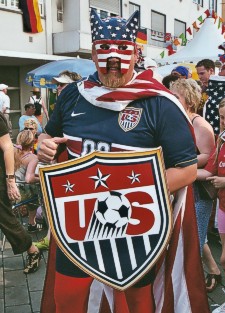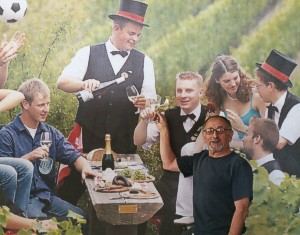
Soccer spirit | Germans Are Killing Again
This Time With Kindness By Ivor Davis 
ORE than six decades ago the Germans were trying to kill me. Every evening during the Blitz my family would stand in our garden in London and listen to the buzz bombs approaching. Many were shot down but many more pierced the defensive guns and when those pilotless bombs – designed by Werner Von Braun – ran out of fuel they fell to earth, destroying houses, killing neighbors and turning streets into rubble. They whined and then they were suddenly silent. It was that terrible silence that indicated they were about to drop. Now some sixty years later I had finally plucked up enough courage to visit Germany for the first time. Once again they tried to kill me. This time with kindness. I must admit that in countless trips to Europe, I had carefully avoided visiting Germany, having no desire to see the fatherland that had left me with such dark memories. But this summer, as a football (soccer to you) devotee, I headed to Germany to cover the World Cup for a Southern California radio station. Everything at the airport was ultramodern, well lit, clean, efficient—"like a giant Ikea," one of my companions quipped. I’m a dual citizen, with US and British nationalities, so when I travel in Europe I use my Euro-British passport. Less complicated. I headed into the medieval city of Nuremberg whose name carries such freight for anyone who was around in World War II, and for Jews so much more so. Anti-Semitism goes back a long way in Bavaria. In the 13th century hundreds of Jews were massacred. In the 20th century Nuremberg gave its name to laws that marked the end of the life and liberty Jews had enjoyed for so long. In the thirties it was the place where Hitler displayed his might to the world, the scene of his most fervent rallies—the Nazi national shrine where film maker Leni Riefenstahl captured the frenzied Fuhrer in her l934 propaganda movie, Triumph of the Will. It was in Nuremberg where from l945-l949 the most heinous war criminals had their day in court. Where the "I was following orders" henchmen—Hess, Ribbentrop, Goring— tried to defend their bestial behavior. Now it has risen from the ashes to act as one of the host cities for the World Cup. 
Ivor in front of a mural in downtown Nuremberg | We were in a downtown area known as "The Fan Zone"—and on a gorgeous summer afternoon thousands of young Americans strolled happily through the streets, their faces painted red, white and blue, wearing the Stars and Stripes as a cloak, with some dressed as Captain America, George Washington, and a handful sporting Nixon and Elvis masks. It was as if I had walked into a bizarre fancy dress party—an unreal carnival as the fans marched through the streets chanting "USA…USA" before the American team took on Ghana. (And lost, in case you didn’t hear.) It was hard to realize that seventy years ago these streets were filled with strutting, swastika-clad Germans in a preamble to what turned out to be the bloodiest chapter of a bloody century. The Germans were on their best behavior, acutely aware of the need to project the image of the New Germany—friendly, hospitable, open, tolerant—greeting all comers no matter their race or color, trying their best to demonstrate that at last Germany is a nation just like any other, normal at last. A Jew can visit without that nasty feeling that a greater percentage of the population here wish him ill. It was impossible not to share in the Germans’ new-found delight in their relaxed position in Europe and their new image in the world. Unlike their former ally Austria, who has somehow managed to sell the world on the idea that they too were victims of Nazism rather than enthusiastic participants, Germany has confessed their sins, made their mea culpas and paid their reparations to the victims and Israel. While Germany didn’t win the World Cup they reached the semifinals—quite an achievement. But a far greater one was to run a World cup without serious scandal or unpleasantness and to show the world that Germans know how to have fun. "We were so serious before," a German fan told me, "but now we’ve shown that we can party. And we’ve surprised the world." Germany is a beautiful country with nice people. Go and enjoy. |